Still going on the Chile-Argentina naval arms race of the 1890s, the follow-up of the 25 de Mayo was the 9 de Julio, larger and better armed. Also an Elswick ship, she was a 22 knots protected cruiser mixing 5 and 4.7 in guns which had a largely uneventful career until being stricken in 1838. #ww1 #armadadeargentina #argentiniannavy #cruiser #9dejulio
⚙ The naval Arms Race | |
 Armada de Argentina Armada de Argentina |  Armada de Chile Armada de Chile |
| Libertad class (BB) 1887 Veinticinco de Mayo (PC) 1890 Nueve de Julio (PC) 1891 Buenos Aires (PC) 1894 Garibaldi (AC) 1895 San Martín (AC) 1896 Pueyrredón (AC) 1897 General Belgrano (AC) 1898 Rivadavia, Moreno* (AC) 1901 |
Capitán Prat (BB*) 1887 Presidente Errázuriz (PC) 1887 Presidente Pinto (PC) 1887 Blanco Encalada (PC) 1892 Esmeralda (AC) 1894 Ministro Zenteno (PC) 1894 O'Higgins (AC) 1896 Constitución class (BB) 1901 Chacabuco (PC) 1901 |
Design Genesis
In 1890, the Argentine government headed by President Miguel Juárez Celman decided to purchase new cruisers in view of the impending conflict with Chile, due to disputes regarding the application of the 1881 Treaty. It was the start the Chile-Argentinian naval arms race, among of the best known and costlier in history, each country trying to out-do the acquisition of its neighbour. Over time and until the “pacts of May”, the budget engulfed in this contest soon appeared far more than these local economies could bear. Unfortunately Brazil relaunched it in 1907 when acquiring new dreadnoughts… This considerable effort also weighted in the way Chile, later plunged into an economical crisis, could modernized its fleet, and still limited Argentinian similar efforts in the interwar.
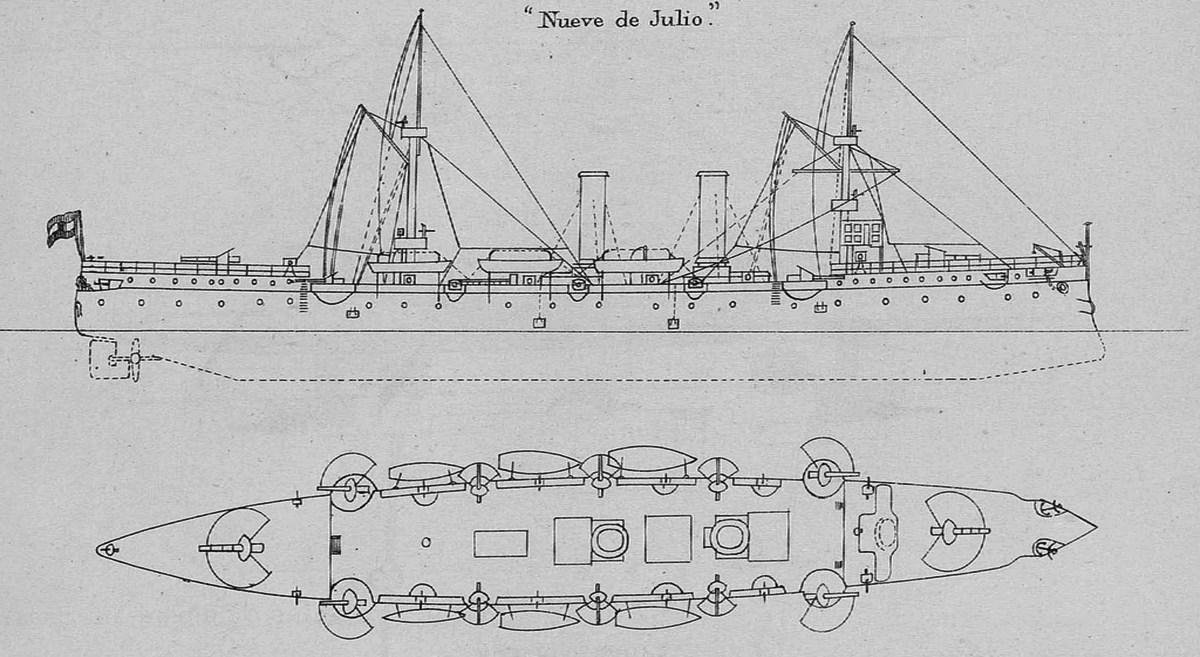
Brassey’s detailed design in the annual 1894
In accordance with his instructions, the Argentine representative to the United Kingdom, Dr. Luis L. Domínguez, signed a contract for £260,000 (1,310,410 m$n gold) with the shipyards W. Armstrong, Michel & Co., in Newcastle- on-Tyne, England, for the construction of a 3,500-ton displacement cruiser named later 25 de Mayo.
That same year but later, Luis L. Domínguez agreed with Armstrong to purchase another, 3,575-ton displacement cruiseer for £293,000, similar, but taking advantage of the experience gained from its early reception for modifications. Bot cruisers had been associated got simplification as the “25 de Mayo class”, but tese are two different animals, hence the separation in two articles.
Design of the class
Hull and general design
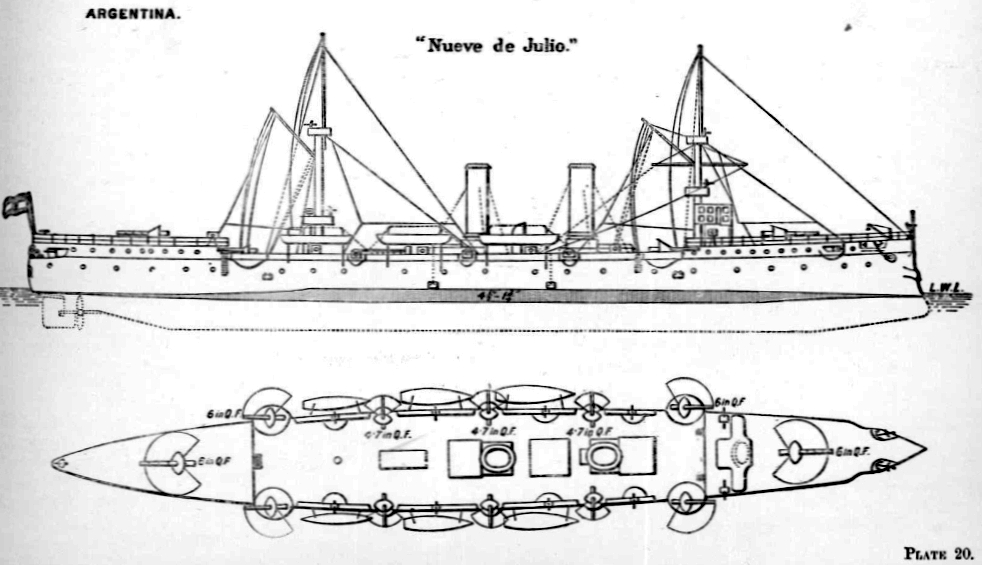
Nueve the Julio was close to the 25 de Mayo in design, just slightly larger at 3,575 tonnes versus 3,500 as specified for the first, and of greater dimensions: The new cruiser measured 113.50 m overall, for 16.10 m in beam and 7.92 m in draught, the hull itself being 5.60 m tall above the waterline. This is to compared to 107.90 (6 meters more), 13.41m beam (3 meters more) and 4.87 m (in draught, so almost 3 meters more). In short, a much larger cruiser. 25 De Mayo also diverged in armament, with a single caliber battery of modern QF 6-in guns.
She had also a new powerfplant capable of 14,500 shp versus 8,500, so quite a jump in capabilities. Speed was a knot faster, range comparable, as the crew, which enjoyed a larger ship with better accomodations.
She had two funnels, two military masts with a conning tower forward and bridge above, and six utility boats, incuding two coal barges, two yawls, and two steam cutters above the battery deck, mounted under davits. These broadsides were quite “busy” with nine guns of different calibers along the bulwarks.
Armour protection layout
This was a repeat of the previous clsass, with some detail changes, with the following fugures:
Armour deck: 4.5–3.5 in (114–89 mm) on slopes, 3.5–1.75 in (89–44 mm) on flat
Glacis over engines: 5 in (130 mm)
Gun shields: 2 in (51 mm)
Conning tower: 4 in (100 mm)
Powerplant
9 de Julio was powered by two vertical 4-cylinder machines, fed by 8 boilers providing up to 17,000 HP (14.500 shp normal), allowed a maximum speed of 22 knots, cruising speed of 10 knots. With an internal capacity of 770 t of coal, her range was 4,872 miles at cruis speed, a bit less than the 5,000 of her sister 25 de Mayo.
Armament
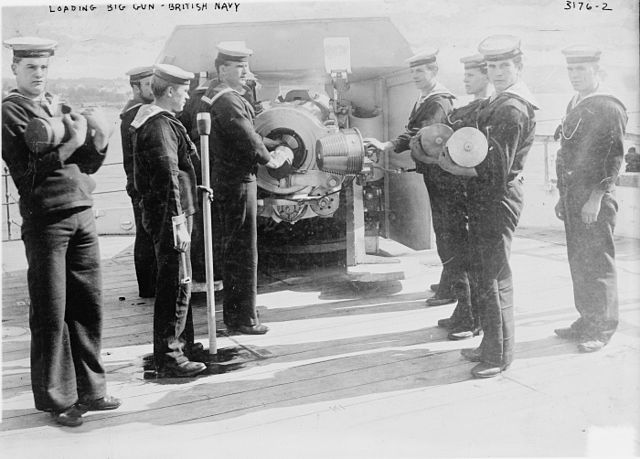
Loading a QF 6-in gun
Main
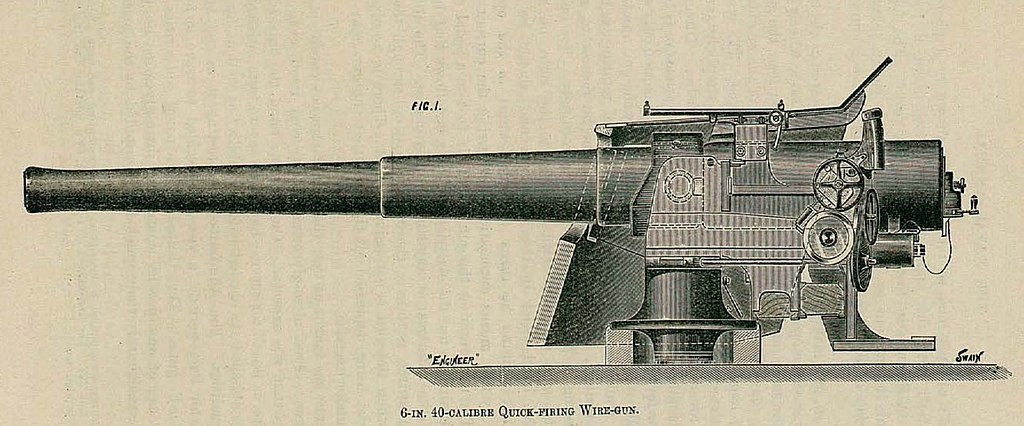
Instead of two 210 mm, slow-firing, the admiralty preferred four Armstrong 150 mm guns, brand new QF guns which had longer range and a much better rate if fire. Three were installed forward in a triangle, one on the forecastle and two on the battery deck behind, sponsons, and the last one aft, axial. They used separate ammunitions, can elevate to +20 degrees, fire 5-7 rounds per minute at a muzzle velocity of 2,154 feet per second (657 m/s) and 10,000 yards (9,140 m) at max elevation or 15,000 yards (13,700 m) at 28°.
Secondary
This was completed by eight 120 mm guns, four per broadside, sponsons on the battery deck. The QF 4.7-inch Mk II naval gun used separate ammunitions, could elevate to 20°, fire at 5–6 rounds per minute at 2,150 feet per second (660 m/s) and 10,000 yards (9,100 m) at 20°. So the full battery had about the same rate of fire and range, which was more practical than the choices made for 25 de Mayo.
Tertiary
This armament was rounded up by twelve 3-pounder (37mm) Hotchkiss rapid-firing guns, installed on deck forward either side of the bridge, in four hull casemates for and aft, eight along the broadside bulwark, battery deck, and the remainder in the fighting tops.
Torpedo Tubes
She had five above water torpedo tubes (two either beam, fixed, one at the bow, for 5m long 460 mm (18-in) caliber Whitehead torpedoes. Other sources says 550 mm (21 in).
Construction
Built under the inspection of the head of the Naval Commission in London, Commodore Enrique Guillermo Howard, 25 de Julio was laid down in slipways on October 15, 1891. About to be launched, the crew and officers arrived aboard ARA Almirante Brown and boarded 25 de Mayo. The new inspection commission was chaired by designated commander Captain Martín Rivadavia, Lieutenant Onofre Betbeder and Ensigns Diego C. García, Ismael Galíndez and Exequiel Guttero. After making several last-minute modifications to the hull, the launch proceeded by July 1892. She was completed in December 1892, making her first trials in January-February 1893.
The construction of both her and 25 de Mayo had an imediate effect on Chile, which until there, had purchased three warships in France. A modern battleship, Capitan Prat, out-doing the Argentinian Libertad class, and two cruisers of the Pdt. Pinto class; However the latter were rather mediocre and were answered in form by Argentina. The next ordes as decided would be also to Britain, ordering basically to the same yard (Vickers Arsmtrong) a pair of larger ships to completely outclass the Argentinian cruisers: Esmeralda and Blanco Encalada. But this is for the next time…

⚙ 21 de Julio specifications |
|
| Displacement | 3,575 t standard |
| Dimensions | 107.9 oa x 13.4 x 5 m (354 x 44 x 16 ft 6 in) |
| Propulsion | 2 shafts VTE, 8 cyl. Boilers 14,500 HP ihp (10,100 kW) |
| Speed | 22 knots (40 km/h; 26 mph) |
| Range | 350-750t coal, 4,872 nmi (9,000 km) at 10 knots |
| Armament | 4x 6-in, 8x 4.7 in, 12x 3-pdr Hotchkiss, 5x 18-in mm TTs. |
| Armor | Belt 127 mm (5-in), armor deck 1-in (25 mm) CT 1-in |
| Crew | 346 total |
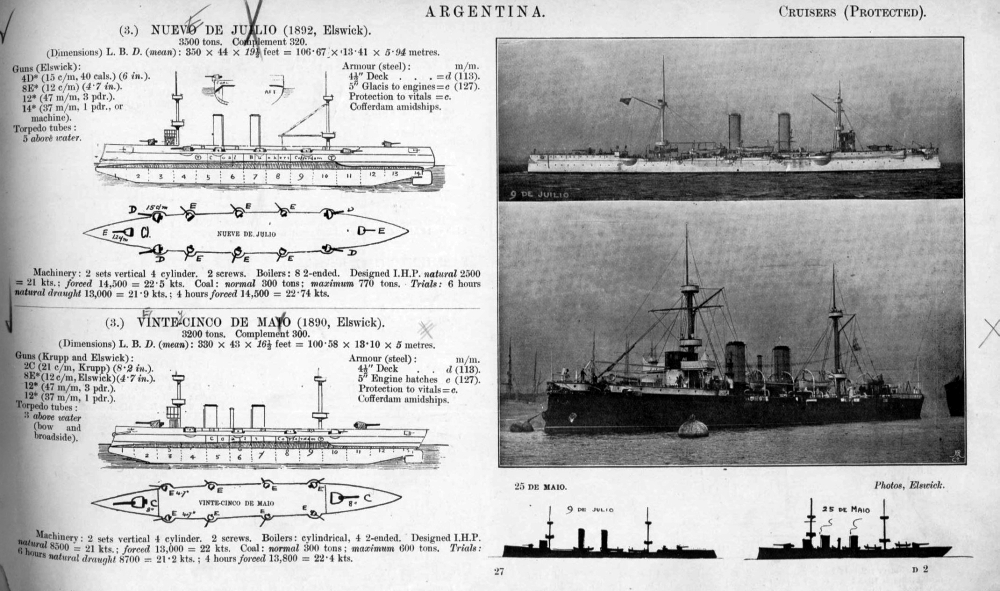
Brassey’s page comparing both cruisers.
Links/Sources
Books
J. Gardiner’s Conway’s all the world’s fighting ships 1865-1906
Teodoro Caillet-Bois, Historia Naval Argentina, 1944, Imprenta López, Buenos Aires
Arguindeguy, Pablo E. CL, y Rodríguez, Horacio CL; “Buques de la Armada Argentina 1852-1899 sus comandos y operaciones” Instituto Nacional Browniano 1999.
Links
on es.wikipedia.org
on histarmar.com.ar
on todoababor.es/
on argentina.gob.ar
Career
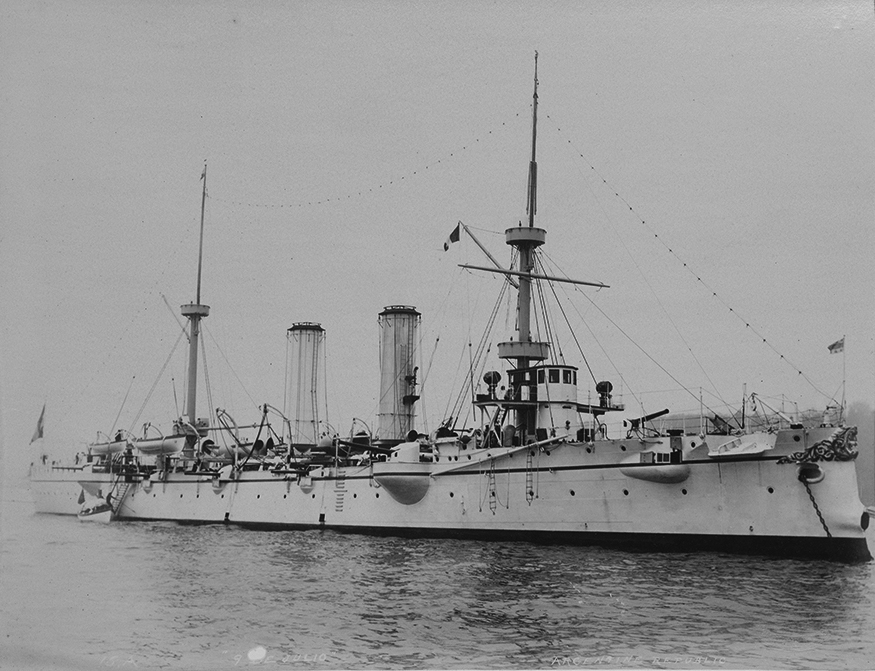
On November 24, 1892, Martín Rivadavia took command of the ship after the completion phase, supervised on January 24, 1893 machinery tests, artillery tests on the 25th. Commodore Howard and representative of the Argentine Navy boarded the ship during festivities to be held in the United States to commemorate the Discovery of the Americas. For this, she left the Tyne on April 2, 1893, bound for New York.
After a violent storm lasting several days, 9 de Julio arrived in the Azores on February 9, and at its destination, NY City on the 17th. She later left for the south coast. On April 25, she took part in the 1893 Naval Review in Hampton Roads, together with the American squadron (Rear Admiral Gherardi) aboard flagship cruiser USS Philadelphia, the first squadron under Rear Admiral Benham, with cruisers USS Newark, Atlanta, San Francisco and Baltimore, gunboats Bancroft, Bennington, the 2nd Squadron of Rear Admiral Walker (cruiser USS Chicago, Charleston and the dynamite gun cruiser USS Vesuvius, the gunboats USS Yorktown and Concord, TB USS Cushing. The RN was also there with flagship HMS Blake (Vice Admiral Hopkins), HMS Australia, Magicienne, Tartar, the Russian cruisers General Admiral, Dmitrii Donskoi, Vitiaz, French cruisers Jean Bart and Aréthuse, gunboat Hussard (Rear Admiral Libran), Italian cruisers Etna, Giovanni Bausan and Dogali (Rear Admiral Magnaghi), Spanish cruisers Infanta Isabel and Reina Regente, TB Nueva España, Brazilian battleship Aquidabã, cruisers Tiradentes and República, German cruisers Kaiserin Augusta and Seeadler, Dutch Van Speyk and new Mexican Zaragoza.
On April 28, 9 of Julio’s crew landed and led by lieutenant José Quiroga Furque paraded in New York. On May 24, she sailed to the Carribean, stopping in French Martinique, assisted the stranded Samborombón and arrived on June 29 off Punta Indio. She took no part in the Revolution of 1893. By December she entered dry dock in Montevideo for maintenance.
In 1894 she became flagship of the 2nd Division, with her sister 25 de Mayo and Patagonia. After the October 14 naval review, the Chinese government made a proposal to the Argentinian Government to aquire both Argentinian cruisers as well as Admiral Brown to bolster their fleet (£200,000 for the three) as the First Sino-Japanese War just broke out in August. This was refused and the Chinese fleet was defeated at Yalu in September). This refusal was officially to not break its trade relationship with the Empire of Japan.
In March 1895, frigate captain Edelmiro Correa took command and by August XO Lt. Onofre Betbeder, broought the ship to the Cibils dock in Montevideo. After maintenancen, the cruiser was back in squadron operations by October under captain A.S. Barilari and by September 1896 she became flagship again in Rio de Janeiro, receiving a honorary new flag embroidered by ladies of that city as a mark of diplomatic good will. On April 7, 1897, under command of captain Eduardo O’Connor she was assigned to the 1st Division with the new cruiser ARA Buenos Aires, 25 de Mayo and Espora until October and she joined the Instruction Division, still with 25 de Mayo and the battleships Libertad, Patria and Admiral Brown.
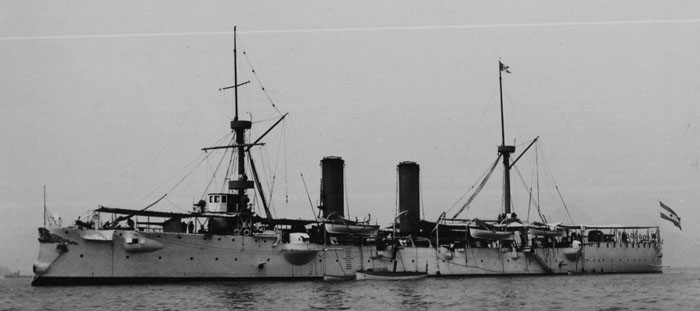
In July 1898, Commander Hipólito Oliva took command followed the next year by Gregorio Aguerriberry, taking part in South Atlantic maneouvers taken her south to Ushuaia in the summer to avoid pack ice. By September she went to Rio Santiago for a semi-reserve. The next yer spent in the Cruiser Division repeated this routine between semi-reserve, active manoeuvers, instruction squadron, under the successive command of captains Lorenzo Irigaray, Hortensio Thwaites and by late 1902 she was again in Río Santiago under Commander Mariano Saracho.
On 1903-1904 this were Manuel Lagos and Servando Cardoso. In September 1905, fully operational, she traveled to Brazil but on the 29th, ran aground in Bahía de Itá Pocoroya. She was helped by ARA Independencia and the 25 de Mayo. In November Eduardo O’Connor retook command as she underwent repairs.
In April 1906, captain Gregorio Aguerriberry assumed command, then Diógenes Aguirre during her refit of August. In 1907 Protasio Lamas took command, then Diego García, when she was used as training ship for Apprentice Gunners, cruising to Ushuaia.
November to February 1908 she was under Guillermo Scott, and then Alfredo Malbrán for 2nd Division exercizes aletrnating with training duties for gunners, then Apprentice Machinists and Firefighters under Diego Garcia.
In early 1909 she sortied in full commission under Alfredo Malbrán for squadron maneuvers of the 2nd Division until May 25. In October when docked, she rammed by accident the Dársena Norte pier, damaging her spur, which sent her to drydock for repair.
In August 1909, Lorenzo Saborido took command for Division maneuvers off the Patagonian coast in 1910, then the celebrations of the Argentine Centennial on June 10.
In 1911 under captain Virgilio Moreno Vera she made protocol missiones to Montevideo in August and Rio de Janeiro in November. Until November 1913 still wth the 2nd Division she was anchored at the Río de la Plata under Moreno Vera and Ángel Elias, then Juan Sancassanni by October, before being reassigned to the Training Division, like her near-sister 125 de Mayo, tasked of training the cres of the new battleship Rivadavia.
In 1915, while under maintenance, she was rassigned to the 2nd Division and left for Rio de Janeiro fir its national holidays parade. In 1916, under captain Carlos Somosa she made training trip for the cadets of the Naval School and was assigned to the Training Division at Puerto Belgrano. In December under Captain Carlos M. Valladares she made a South Atlantic trade surveillance mission as U-Boat activities increased dramatically by late 1916.
Unrestricted submarine warfare meant now that any argentinian vessel was under threat and the Argentinian Navy was fully mobilized for neutrality patrols. Under Valladares and Julio Mendeville by 1917 the cruiser 9 de Julio became an auxiliary ship for the 1st Division with the battleships Moreno and Rivadavia. On September 28, she left for Comodoro Rivadavia under command of captain Gabriel Albarracín to repress an oil workers strike. She captured German steamships, the Namplia and Bahía Blanca in Madryn. They fled a RN squadron operating in the South Atlantic. After the war in November Arturo Cueto took command and later Luis Orlandini, then Francisco de la Fuente, taking part in exercises of the 1st Division.
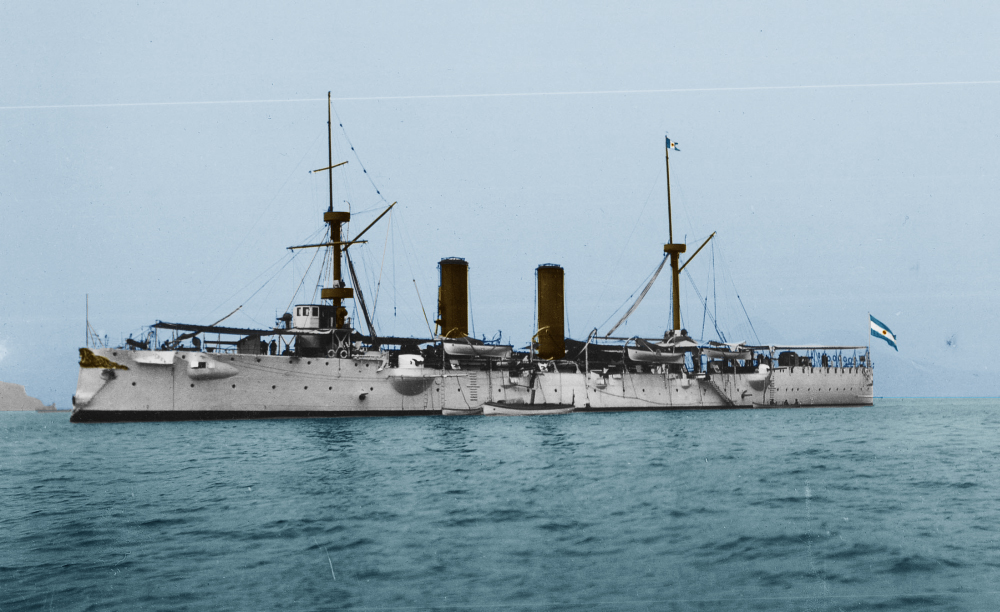
In 1919 she returned with the 2nd Division, taking part in the events of the “Tragic Week” and later awarded a plaque by the government.
In 1920, she remained under Enrique líate as training ship. On May 21, 1921, under Osvaldo Fernández she took part in the maneuvers of the 2nd Division.
In December 1922, she was assigned as tender to the Naval Aviation School, stationed at Puerto Belgrano. In July she cruised to Ushuaia in anticipation of a new insurrection. In 1923-1924 she was commanded by Tadeo Méndez and Juan G. Ezquerra.
In 1925 she remained with the Naval Aviation School but she was to be disarmed while under command of captain Francisco de la Fuente. By October 1926 while in Río Santiago, she became an accommodation ship for the Torpedo, Electricity and Fourrier Schools, until 1929 under Rodolfo Barilari and José R. Blanch. On October 23, she was officially stricken but kept her role of barrack ship until 1938, completely disarmed but with her superstructure remaining. She was transferred to Dock “E”, Puerto Nuevo for scrapping. This was performed by the military Steel Factory but on August 18, 1938, the plating near the engine rooms gave way and she was quickly flooded, sinking. In 1947 her remains were raised and she was towed to the Dársena Norte Drydock for scrapping.


 Latest Facebook Entry -
Latest Facebook Entry -  X(Tweeter) Naval Encyclopedia's deck archive
X(Tweeter) Naval Encyclopedia's deck archive Instagram (@navalencyc)
Instagram (@navalencyc)





 Austrian Navy
Austrian Navy French Navy
French Navy Royal Navy
Royal Navy Armada Espanola
Armada Espanola K.u.K. Kriegsmarine
K.u.K. Kriegsmarine Dansk Marine
Dansk Marine Nautiko Hellenon
Nautiko Hellenon Koninklije Marine 1870
Koninklije Marine 1870 Marinha do Brasil
Marinha do Brasil Osmanlı Donanması
Osmanlı Donanması Marina Do Peru
Marina Do Peru Marinha do Portugal
Marinha do Portugal Regia Marina 1870
Regia Marina 1870 Nihhon Kaigun 1870
Nihhon Kaigun 1870 Preußische Marine 1870
Preußische Marine 1870 Russkiy Flot 1870
Russkiy Flot 1870 Svenska marinen
Svenska marinen Søværnet
Søværnet Union Navy
Union Navy Confederate Navy
Confederate Navy Armada de Argentina
Armada de Argentina Imperial Chinese Navy
Imperial Chinese Navy Marinha do Portugal
Marinha do Portugal Mexico
Mexico Kaiserliche Marine
Kaiserliche Marine 1898 US Navy
1898 US Navy Russkiy Flot
Russkiy Flot French Naval Aviation
French Naval Aviation Russian Naval Aviation
Russian Naval Aviation Sovietskiy Flot
Sovietskiy Flot Royal Canadian Navy
Royal Canadian Navy Royal Australian Navy
Royal Australian Navy RNZN Fleet
RNZN Fleet Chinese Navy 1937
Chinese Navy 1937 Kriegsmarine
Kriegsmarine Chilean Navy
Chilean Navy Danish Navy
Danish Navy Finnish Navy
Finnish Navy Hellenic Navy
Hellenic Navy Polish Navy
Polish Navy Romanian Navy
Romanian Navy Turkish Navy
Turkish Navy Royal Yugoslav Navy
Royal Yugoslav Navy Royal Thai Navy
Royal Thai Navy Minor Navies
Minor Navies Albania
Albania Austria
Austria Belgium
Belgium Columbia
Columbia Costa Rica
Costa Rica Cuba
Cuba Czechoslovakia
Czechoslovakia Dominican Republic
Dominican Republic Haiti
Haiti Hungary
Hungary Honduras
Honduras Estonia
Estonia Iceland
Iceland Eire
Eire Equador
Equador Iran
Iran Iraq
Iraq Latvia
Latvia Liberia
Liberia Lithuania
Lithuania Mandchukuo
Mandchukuo Morocco
Morocco Nicaragua
Nicaragua Persia
Persia San Salvador
San Salvador Sarawak
Sarawak Uruguay
Uruguay Venezuela
Venezuela Zanzibar
Zanzibar Warsaw Pact Navies
Warsaw Pact Navies Bulgaria
Bulgaria Hungary
Hungary

 Bundesmarine
Bundesmarine Dutch Navy
Dutch Navy Hellenic Navy
Hellenic Navy Marina Militare
Marina Militare Taiwanese Navy
Taiwanese Navy Chinese Navy
Chinese Navy Indian Navy
Indian Navy Indonesian Navy
Indonesian Navy JMSDF
JMSDF North Korean Navy
North Korean Navy Philippines Navy
Philippines Navy ROKN
ROKN IDF Navy
IDF Navy Royal New Zealand Navy
Royal New Zealand Navy Egyptian Navy
Egyptian Navy South African Navy
South African Navy

































 RN
RN
 Marine Nationale
Marine Nationale
 Soviet Navy
Soviet Navy
 dbodesign
dbodesign